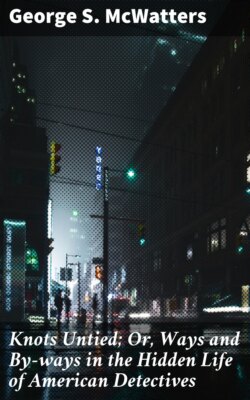Читать книгу Knots Untied; Or, Ways and By-ways in the Hidden Life of American Detectives - George S. McWatters - Страница 26
На сайте Литреса книга снята с продажи.
"Riot Week," July, 1863: Officer McWatters in the Thick of the Fight.
ОглавлениеTable of Contents
During the whole war nothing of a more fearful nature to the cause of the Union occurred than the great riot in New York city, which commenced on Monday, the 13th of July, 1863, and was not subdued until the following Friday. The people of the North were, to a considerable extent, becoming weary of the war, and thousands, if not tens of thousands, who had previously exhibited a good degree of sturdy patriotism, began to wane in their vigor and firmness of purpose, and were ready to "let the rebels go in peace hereafter." But the facts of those perilous days are too fresh in the memory of all to need recital here. The rioters were exultant, and the people stood aghast for a while; but finally the Metropolitan Police force obtained ascendency over the surging elements of the local rebellion, and brought back peace to the city again. But this was not done without more severe effort and a greater destruction of life than was generally understood by the country at large at that time.
Before us is a book, entitled "Record of the Police during the July Riots, 1863," by David M. Barnes, in the preface of which the author, speaking of the slaughters during those days, says, "The number killed by the police and military in the different conflicts, when alone and united, can never be ascertained; it is estimated by those who witnessed the scenes, and had the best opportunity of judging, at fourteen hundred. The bodies of those killed on the spot were hurriedly taken off, and in many cases conveyed out of the city, or secreted here, and privately buried. Cases of subsequent deaths from wounds, it is known, were attributed to other causes. Eighteen persons are known to have been killed by the rioters, eleven of whom were colored."
We confess ourselves somewhat astonished at so large an estimate of the number killed during the riot; but those were horrible days, indeed, and the estimate is, we think, quite probably within the limits of the truth. The book was published in September, 1863, it appears—a date a sufficiently long time after the riots to have allowed much careful investigation to have been made. Among the other heroes of those days, whom the author signalizes by especial mention by name—Commissioner Acton, Superintendent Kennedy, Commissioner Bergen, Chief Clerk Hawley, Inspectors Carpenter, Dilks, and Leonard, etc.—is found our chief subject, as brave, active, earnest, and efficient in the midst of a deathly struggle, as he is ever gentle, kind, and tender in his silent ministrations to the sick, sore, and suffering in the days of peace. On page eighty-two of the book referred to, and where the special history of the conduct of the police of the Twenty-Sixth Precinct is detailed in regard to their conflicts with the mob in the City Hall Park, Printing House Square, and the Tribune Office, the author says—
"No mercy was shown, and over a hundred lay in the square and park, the well-punished victims of their own folly and crime. While the mob were being thus terribly handled in the street, some of the force turned their attention to the Tribune Building, fighting their way to, and entering it. The fire had just been lighted, and was readily extinguished. Officer McWatters, on entering the door, was assaulted by a burly ruffian, armed with a hay-rung, who, by a powerful blow on the shoulder, knocked him down; instantly on his feet again, he more than repaid, on the heads of the rioters, the blow. The building was cleared speedily, and not a man in it escaped without severe punishment."
But it is unnecessary to extend comment upon the career of Officer McWatters, as related to the active operations of the war. As a patriot, his name is not only "without spot or blemish," but is one of which the best of citizens might be proud, and of which only such could have made themselves worthy.
